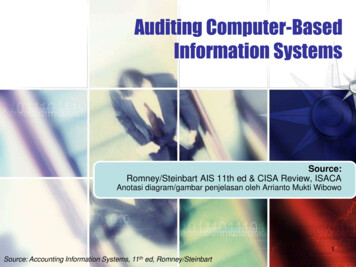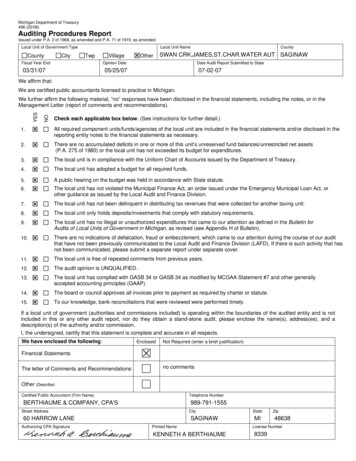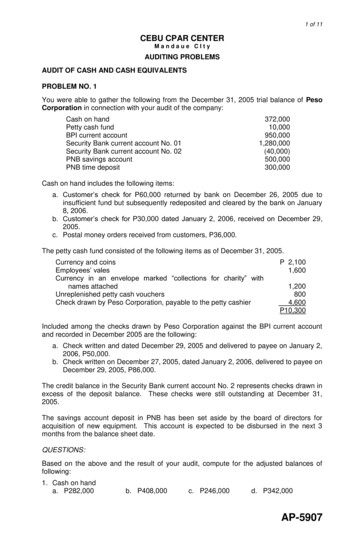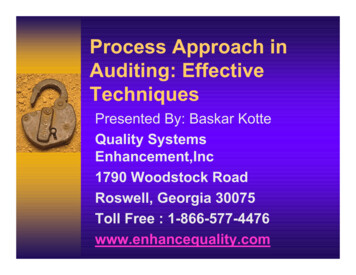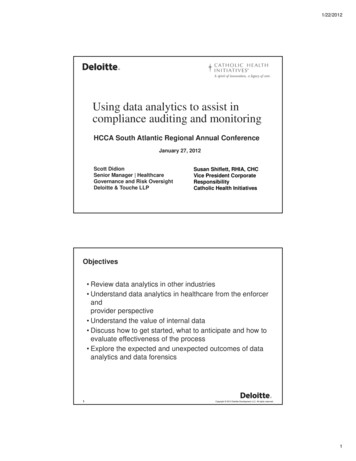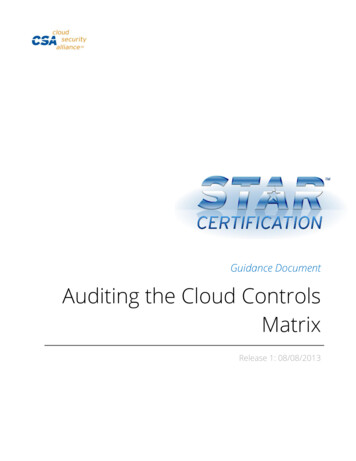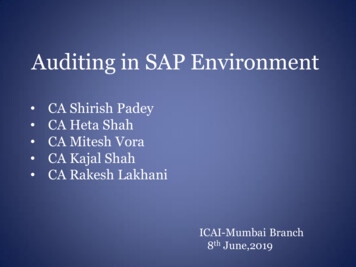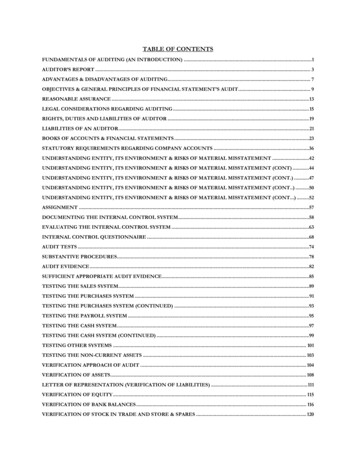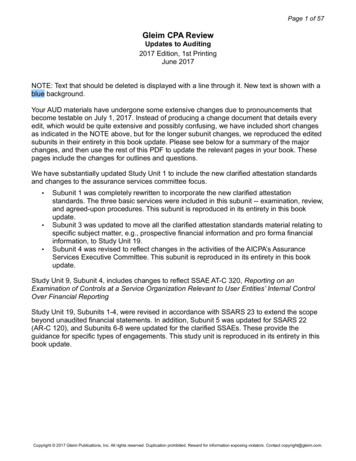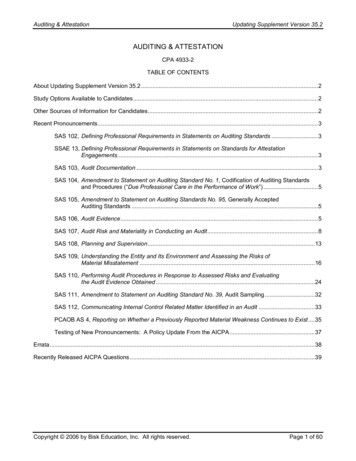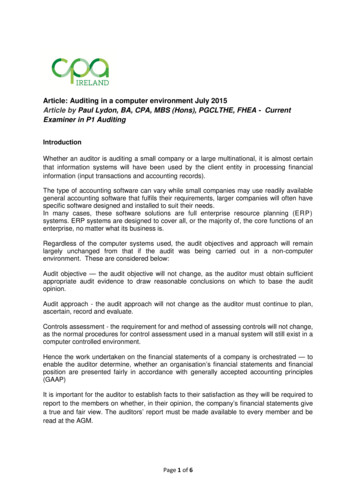
Transcription
Article: Auditing in a computer environment July 2015Article by Paul Lydon, BA, CPA, MBS (Hons), PGCLTHE, FHEA - CurrentExaminer in P1 AuditingIntroductionWhether an auditor is auditing a small company or a large multinational, it is almost certainthat information systems will have been used by the client entity in processing financialinformation (input transactions and accounting records).The type of accounting software can vary while small companies may use readily availablegeneral accounting software that fulfils their requirements, larger companies will often havespecific software designed and installed to suit their needs.In many cases, these software solutions are full enterprise resource planning (ERP)systems. ERP systems are designed to cover all, or the majority of, the core functions of anenterprise, no matter what its business is.Regardless of the computer systems used, the audit objectives and approach will remainlargely unchanged from that if the audit was being carried out in a non-computerenvironment. These are considered below:Audit objective — the audit objective will not change, as the auditor must obtain sufficientappropriate audit evidence to draw reasonable conclusions on which to base the auditopinion.Audit approach - the audit approach will not change as the auditor must continue to plan,ascertain, record and evaluate.Controls assessment - the requirement for and method of assessing controls will not change,as the normal procedures for control assessment used in a manual system will still exist in acomputer controlled environment.Hence the work undertaken on the financial statements of a company is orchestrated — toenable the auditor determine, whether an organisation’s financial statements and financialposition are presented fairly in accordance with generally accepted accounting principles(GAAP)It is important for the auditor to establish facts to their satisfaction as they will be required toreport to the members on whether, in their opinion, the company’s financial statements givea true and fair view. The auditors’ report must be made available to every member and beread at the AGM.Page 1 of 6
Audit approach in a computerised environmentAuditing around the computerHistorically the auditor wished to ensure that data was correctly input and generated by thecomputer, this approach is generally referred to as “auditing around the computer”. Thismethodology was primarily focused on ensuring that source documentation was correctlyprocessed and this was verified by checking the output documentation to the sourcedocumentation.Auditing through the computerDue to the advent of “real time” computer environments, there may only be a limited amountof source documentation or paperwork hence the auditor may employ an approach knownas “auditing through the computer”. This involves the auditor performing tests on the IT(Information Technology) controls to evaluate their effectiveness.On completion of the necessary tests, if the auditor is satisfied that the controls are effective,then the auditor may perform a lesser degree of substantive procedures testing.A high degree of skill and experience often involving IT audit specialists is necessary toundertake such an evaluation of the IT controls. In making the decision to test controlsconnected to the computer environment, the auditor will consider: Extent of UseImportance to the Business; andComplexityIT audit and Computer-based auditThe terms “IT audit” and “computer-based audit” are used interchangeably to describe thecontrols operated by computers but from here on the term IT audit will be used.Hence when an auditor undertakes an IT audit is undertaken it is to review and evaluate anorganisation’s information system’s availability, confidentiality, and integrity.This will require the auditor to pose certain questions to ensure:1. AvailabilityPotential question - What measures are in place to ensure that the data is availablewhen required?To answer this question the auditor will access the organisation’s computer system toensure it will be available for the business at all times when required.2. ConfidentialityPotential question - What controls are available to ensure that only authorised personnelcan access the data?The auditor will wish to review and test the confidentiality of the organisation’sinformation to understand that the information in the systems is only disclosed toauthorised users.Page 2 of 6
3. IntegrityPotential question - What controls are in place to prevent unauthorised changes to thedata?Finally the auditor will endeavour to ensure the integrity of the information. This meansthat the information provided by the system is accurate, reliable, and timely.The auditor may also need to consider some other key factors which will influence theeffective application of controls within the IT system.Such of these factors include the following: Whether processing is centralised or decentralisedThe complexity and level of customisation of the IT systemThe availability of skilled and experienced audit staff.Once a decision has been made to evaluate IT controls, there are two major types of controls in computerised systems to be considered.General controls: These are controls over the environment in which the computer system is operated.Broadly speaking, this type of control includes: organisational controls systems development controls maintenance controls access controls other general controlsAs set out above, the key audit objective when reviewing general IT controls is to ensure thatthe integrity, availability and confidentiality of the data is appropriately controlled. In order tomeet this objective, the auditor will look to identify and test relevant control activities undereach of the general control categories as follows:IT Information SecurityIn the area of information security the key risks include allowing access to the information bymore people than is necessary through a failure to implement appropriately logical securityincluding: user names and passwords, a failure to implement a secure user accessmanagement process including a process to approve the setup of new users and to removeaccess once a person leaves employment. It is also important to ensure that there is anappropriate segregation of duties.The key controls include: implementing logical security tools, such as passwords, firewalls virus protection togovern access; appropriate physical and environment security measures are taken; introducing aprocess to govern the granting and removing of access to the systems, and aprocess to review access from time to time to ensure that any segregation of dutiesissues are identified.Page 3 of 6
IT systems Change ControlThe key risks associated with the area of IT change control include the risk that changes arenot properly approved by management and that changes are not fully tested so that theydeliver their objectives.The key controls to address these risks include: the use of Formal Acquisition and Development Procedures, which ensure thatbefore any changes begin they are fully approved by management to ensure thatthey are in line with the organisation’s IT aims and objectives; a procedure to ensure that all which is converted from older systems is fully reviewedto ensure that it has been moved correctly; controls to restrict access and the ability to make changes so that changes cannot becommenced without approval; procedures to ensure that Formal Testing is carried out before the changes areimplemented. This should include testing by users to ensure that they achieve their aims and by ITto ensure that the changes are correctly developed from a technical point of view.IT OperationsThe main risks in the area of IT operations and interfaces are that all scheduled jobs do notrun successfully, that data does not flow accurately from one application to another, thatdata is not appropriately backed up and that additional or unapproved tasks are run on thesystems.The key controls include: a process to monitor all overnight or batch jobs to ensure that these have completedsuccessfully; controls to restrict the ability to make changes to scheduled jobs; a process to identify and follow up on any jobs which fail to run correctly.Application controls: these are controls designed with the objective of ensuring the accuracy andcompleteness of: data input controls data processing controls data output controlsApplication controls are designed to: (i) detect errors before, during and after the processingof specific types of transaction (ii) to support the IT system controls, and (iii) a sound systemof internal control for the entity. Application controls also provide the auditor with the comfortthat the recording processing and the reports generated by the computer system areperformed properly.Page 4 of 6
Data Input ControlsInput controls are extremely important as a lot of errors may occur at the input stage. Thepresence of such controls are designed to ensure that the input data has been authorisedcorrectly, is complete, and accurate. If input errors are detected by the IT system, theseneed to be reviewed, corrected and resubmitted for inputting into the system again.These controls include the following: Control TotalsHash TotalsEditing ChecksKey VerificationMissing Data CheckCheck Digit VerificationSequence CheckControl TotalsManual Visual ScanningData Processing ControlsProcessing controls are designed to provide reasonable assurance that the computer processes have been performed as intended. They ensure that the transactions are not duplicated or lost or improperly changed in any way and that errors are identified and corrected ona timely basis.These controls include the following: Reasonableness ChecksFind Identification LabelsBefore & After ReportControl TotalsData Output ControlsData output controls are designed to ensure that the processing has been correctly carriedout, and the output reports are then distributed to authorised personnel only.These controls include the following: Visual ScanningReconciliationPage 5 of 6
Cloud computingCloud computing as a technology has significantly progressed in commercial computing.One of its key attributes is the ability to distribute computing tasks to a shared pool ofresources, which can be accessed quickly with a minimal amount of effort for management.Cloud computing endeavours to provide easy access to information systems services bycombining information systems infrastructure and applications that can be retrievedthrough/over the Internet. The five essential characteristics of cloud computing are asfollows: On demand self-service, namely availability of cloud services on demand Broad network access, services are accessible over the Internet through a rangeof devices such as laptops, smart phones and tablets etc. Resource pooling, this allows resources to serve multiple clients, which areconfigured to meet clients’ individual needs. Rapid elasticity, the provider can swiftly scale up and rapidly release services andresources. Measured service, the use of resources by clients can be monitored, controlled andreported on by the provider.This article has attempted to introduce a general review of the audit approach in acomputerised environment. The reader should consult relevant texts and recommendedreadings for further details on the different controls mentioned in this article.Bibliography:Modern Auditing, 3rd Edition 2008/ Cosserat and Rodda, Wiley.The Audit Process: Principles, Practice and Cases 6th Edition 2015 Gray, Manson andCrawford, Cengage Learning.External Auditing and Assurance, An Irish Textbook 2nd Edition 2013, Nolan and Nangle,Chartered Accountants Ireland.Page 6 of 6
Auditing around the computer . Historically the auditor wished to ensure that data was correctly input and generated by the computer, this approach is generally referred to as “auditing aThis round the computer”. methodology was primarily focused on ensuring that source documentation was correctly
